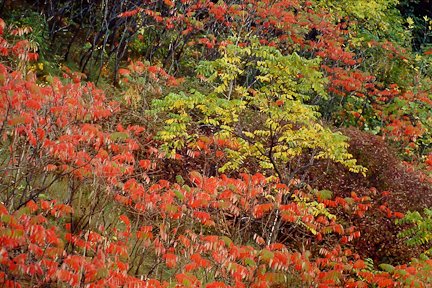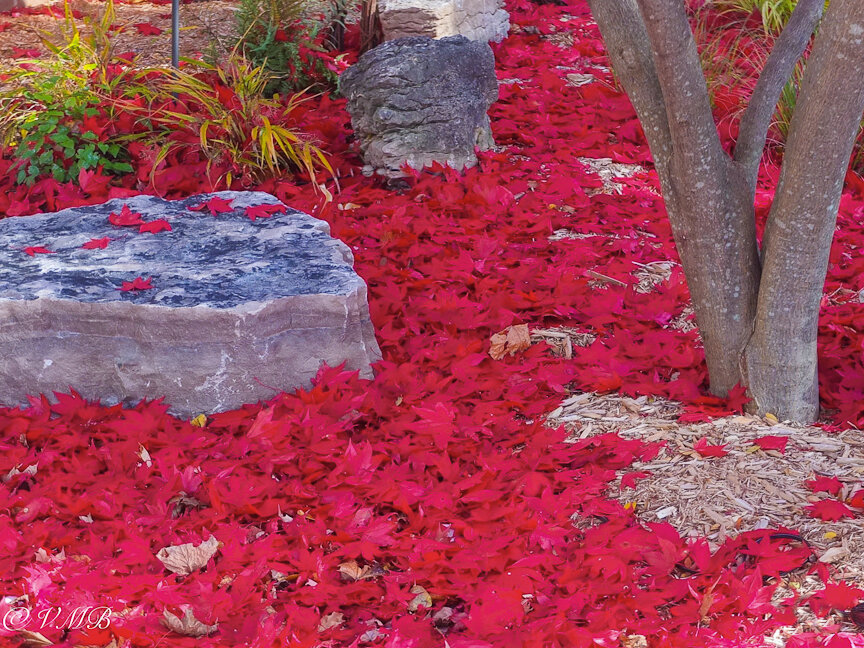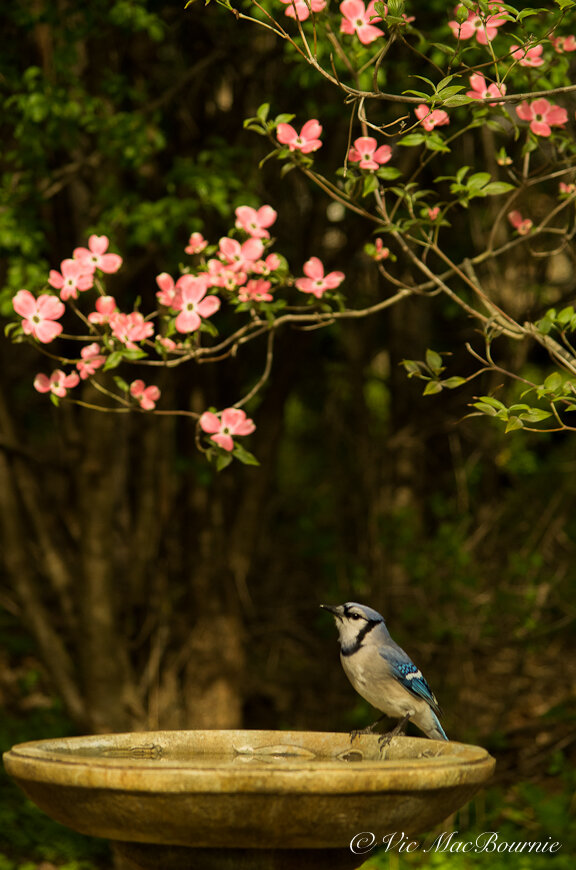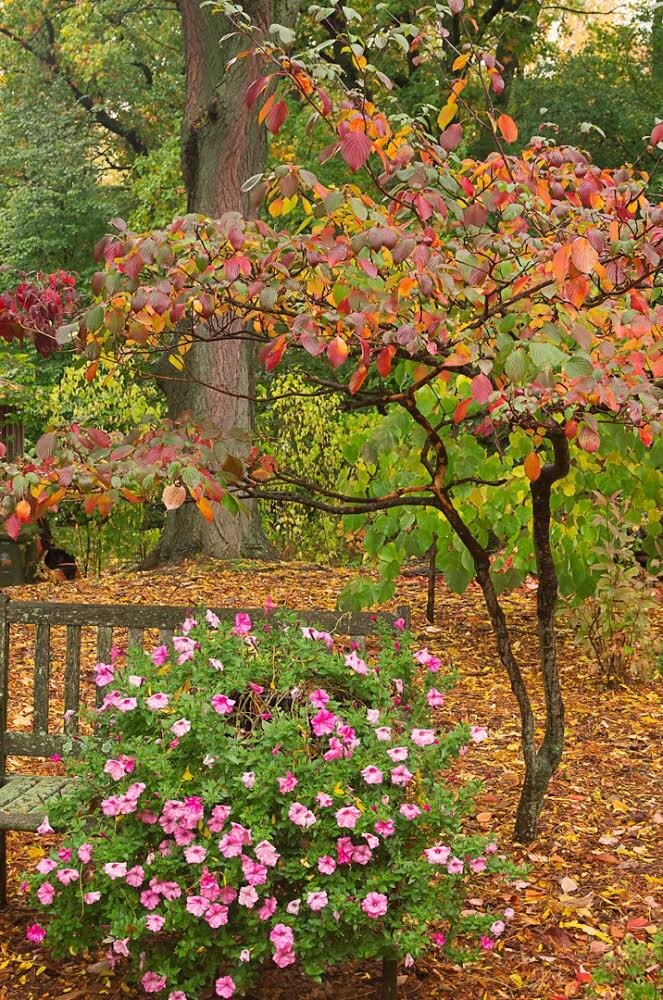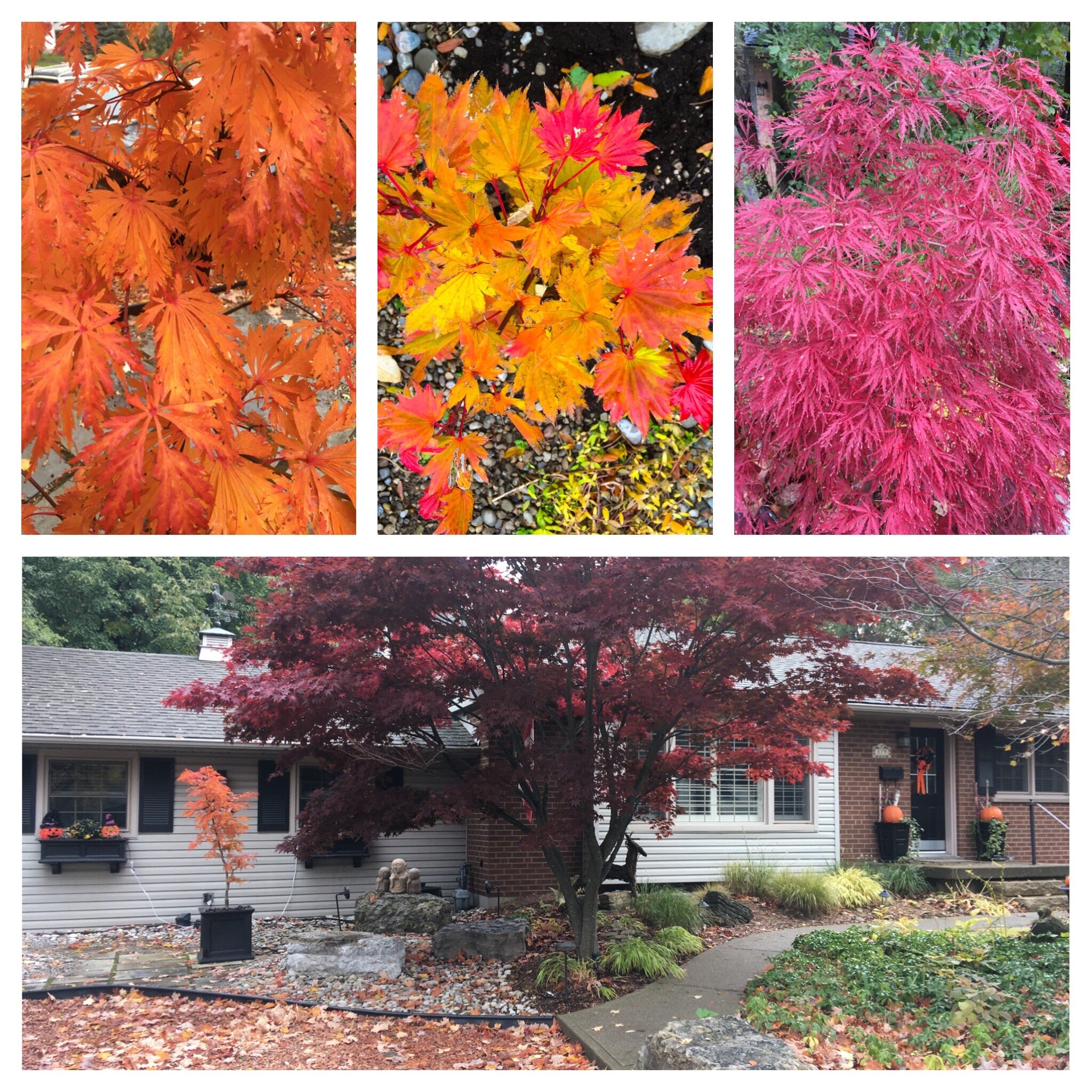Celebrate autumn: Six of the best fall colour trees for your woodland
Here are six of the best trees for fall colour in your woodland garden. Three are for the upper canopy and three are understory trees. Among the best trees for fall colour include the Sugar Maple, The Oaks and the Tulip Tree, as well as trees in the Dogwood family, serviceberries, and Japanese Maples.
Best upper canopy trees and understory trees for your garden
The thousands of yellow fern-like fronds that fall from our massive Locust trees create a natural ground cover much nicer than any cedar mulch.
Even on their short journey down, they become magical filling the air with yellow butterfly-like leaflets before gently reaching their destinations where, for a few short weeks, they form that natural ground cover.
It’s the magic of fall in the woodland garden.
Upper story trees like the Sugar Maple, Red Oak, Locust and Tulip Trees are excellent starting points. Under story trees like Dogwoods, Japanese Maples and serviceberries are perfect understory trees along with Hawthorns and Crabapples.
At our home we embrace the joy of fall colour.
The reds and burnt oranges of the Sugar Maples, the delicate orange of a lovely Japanese Maple alongside the deep rich reds of another Acer on the path leading to our front door. In the back, the yellow of the Birch trees begin early along with the Locusts followed a little later by our mature Linden tree that drops such a profusion of leaves that the ground is almost completely hidden.
Fall can either be a time of celebration, or a dreaded month’s long period where your only goal is to pick up every last leaf that dares to fall on your property.
Make it a celebration.
A woodland of Sugar Maple in full bloom can be breathtaking, but so too can a single tree in a woodland garden.
Embrace the fall colours on the trees, and when the leaves fall to the ground, celebrate them.
Leave them be on the ground for the insects, birds and other garden critters to celebrate. Enjoy the crunch under your feet and breathe in the damp, musty fall air as the leaves begin to break down into the hummus that feeds our woodlands.
As a woodland gardener, Fall should be one of the best times in your garden.
If it falls a little short, it might be because you are missing out of some of the best fall colour trees.
Get garden ready over winter
Three years with a bad hip made my ability to work in the garden extremely difficult. Following a hip replacement, I knew I had a lot of work to do to prepare myself for another garden season, and the best way to achieve that was to begin walking.
If you need to either get in shape for gardening or lose a few pounds, I highly recommend walking your way to health. Today, I walk 12,000 steps a day and I owe my new found health and ability to work in the garden to two devices – a Fitbit and Nordic Walking Poles.
The Fitbit allows you to track your increasing fitness levels, while the Nordic Walking Poles not only provide a full-body workout, but they also help you exercise longer while reducing stress on both your knees and hips.
Our Bloodgood Japanese Maple’s bright red leaves cover the ground in the japanese-inspired garden.
Best trees for fall colour in your garden
I’ve put together a grouping of our best trees for fall colour. Three trees that will form the upper canopy of your shade or woodland garden.
These are the big boys that grow tall and form the backbone of your woodland, providing shade for the understory trees, the shrubs and groundcovers all the while providing much needed shade for us gardeners.
Then, we’ll take a look at some of my favourite under story trees that give us a punch of colour closer to eye level.
The Sugar Maple (acer saccharum)
If you are lucky enough to live in the north east United States or Canada or any area where you can grow a sugar maple, your fall-colour dreams are complete.
We are fortunate to have a mature Sugar Maple at the front of our home arching over the driveway. Yes there are a lot of leaves to lug into the back gardens but the show is worth it my friends.
These are large, upper canopy trees that grow best in zones 3 through 7 but can be grown in zone 8 as well. Where they are happy, they can grow upwards of 75 feet tall with a spread of 30 to 50 feet.
In the bright autumn sun, their fall colour can be electric ranging from yellow to gold, burnt orange and red. During the fall rains the colours shine, especially against the almost black of the tree’s trunk and branches.
The Red Oak (Quercus rubra)
Yes, the best native wildlife tree is also one of the top performers when it comes to fall colours. (See my earlier story on why the Oak is the best tree to plant in your garden)
Here is another impressive, upper canopy tree that can also shoot up to 75 feet in zones 3-7, with a similar spread.
The leaves of the Red Oak fall a little short in vibrancy compared to the the Sugar Maple but still sport lovely shades of crimson, red and redish-brown colours in the fall that eventually fade to brown toward the end of fall.
The Pin oak (Quercus palustris), popular in urban landscapes, has similar fall colours to the Red Oak.
The Oaks wait until the maples have finished their fall show before adding a little more colour to our landscapes.
Anyone who has an oak, or one nearby, knows that their spent leaves can be problematic in the sense that they don’t break down in the same way as maples and most other trees. The tough leathery leaves don’t make the best mulch unless they are shredded and they take a long time to break down in a composter, so it’s best to move most of them into a corner of the yard where they can break down in time. This is also best for many forms of wildlife that depend on the oak leaves to overwinter.
In our garden, we are lucky that the oak tree is in a wilder part of the woodland in the back of the yard and the leaves are simply left to fall where they may.
Tulip Tree (liriodendron tulipifera)
In our yard, the tulip tree certainly has its moment in the spotlight.
This towering, fast growing native tree of the Carolinian Forest is native to the eastern United States and hardy to zone 5. It also needs to be on every woodland gardener’s radar, not only for its bright green spring foliage and lovely large, but subtle spring flowers, but for its dazzling golden yellow fall show.
These trees can easily become the largest tree in your landscape skyrocketing quickly to such heights as 70-90 feet and over time, in the right conditions, reaching up to even greater heights of 150 feet or more with a width of between 30 to 50 feet wide.
If you are looking for a fast grower to block an eyesore, the tulip tree is certainly one to consider. Keep in mind, however, that the tree will eventually require space in the landscape.
The Flowering Dogwood in its spring flowering regalia is matched only by its beautiful fall colour.
The Dogwoods (Cornus Florida and Cornus Kousa)
Some gardener may ask: Do Dogwoods even have fall color?
Given that these understory trees are so prized for their spring flowers and fall berries along with their elegant horizontal branching habit, they can’t possibly provide fall colour too can they?
Absolutely, and it’s magnificent.
The green ovate leaves of the dogwoods take on an attractive almost stunning reddish-purple in fall putting on a show that comes close to matching their spectacular spring show.
The combination of red leaves, often sporting hints of lingering greens, combined with its bright berries makes the flowering dogwood a must in any fall landscape. When the blue jays and cardinals come to snack on the berries. it’s hard not to admit the trees’ near perfection.
Another native dogwood, The Pagoda Dogwood (cornus alternifolia) is a small dogwood with exceptional fall colour.
The Flowering Dogood can be grown either as a large shrub or small tree in shady, moist rich woodsy soil in hardiness zones from 5-9. It grows to between 15-30 ft. tall and wide with elegant horizontal branching.
It’s considered native from around Maine into southern Ontario’s Carolinian zone and south into illinois and Kansans, and as far south to Florida and Texas.
The non-native Kousa Dogwoods fire up slowly in the fall with the rims of the leaves giving way to a pinkish almost peachy colour that transforms over time into bright red leaves overpowering the remaining green. The result can be spectacular.
All the while, the bright red raspberry-sized fruit continues to cling to the trees if the birds and squirrels have not yet got to them. In any case, the leaves can cling to the trees well into the fall, providing a spot of colour in what may otherwise be a stark landscape.
A collage of our Japanese Maples showing off their fall colours.
Japanese Maples (Acer palmatum)
For pure year-round colour in the landscape, there is no denying that Japanese Maples are at the top of any list.
In our front yard, our mature Bloodgood and delicate Beni Schichihenge compete with the Sugar Maple and a mature serviceberry and, quite frankly, steal the show. They are at their prime later in the season when their competition have completed their fall cycles.
The Beni Schichihenge that features summer foliage of blue-green with cream and rose variegation is as beautiful in its fall show as it is in its summer greens. The soft orange glow of its delicate leaves is a favourite that transforms before our eyes from the comfort of our front picture window. (See my article about creating a window into your woodland)
In the backyard, Japanese Maples take a back stage to other trees for most of the year, but still put on quite a show when the dark burgundy leaves of our Bloodgood Japanese Maple turn fire-engine red right before they drop.
There are too many Japanese Maples to list here, but rest assured that most are excellent fall performers worth investigating.
The serviceberry for fall colour
Even if the serviceberry had little to no fall colour, it would be a star in your landscape. Its value to wildlife (primarily its large purplish berries) and its compact growth habit makes it a highly prized understory tree in today’s urban areas.
That’s to make no mention of the clouds of pollinator-friendly white blooms that cover the tree in early spring. (See my earlier story on the Serviceberry here).
This tough little tree that grows up to 20 feet with a width of between 4 and 15 feet is drought tolerant and grows best in zones 2 through 9.
Fall would not be the same without this lovely tree sparkling in our yards. I consider it such a key component of our woodland wildlife garden that we have several specimens in the backyard and one large mature single-stem tree in the front yard.
Fall colour can vary from yellow to orange to red and everything in between. Often it’s the in between that can be the most striking, when the red leaves are still rimmed with yellows and oranges helping to give the trees a lovely glow in the fall rains or misty mornings.
Tying it all together
In a woodland garden, where, for the most part, shades of greens and textures dominate the summer season, it’s fall that can become the most dramatic season of the year. It’s the time the subtle textures are combined with the bright, vibrant colours of our Maples and the more delicate leaves of the oaks, serviceberries and dogwoods. These combine with the delicate, straw hues of ornamental grasses to create a texture unmatched in so many other garden styles.
Embrace fall. Get out into the garden to admire your natural surroundings and take note of combinations that work so that you can duplicate it in other areas of the garden.
And finally, take a drive into the country. Look for roads that meander through natural forests and woodlands to appreciate – and take notes – how mother nature chooses to celebrate fall.
Different stages of the Sumac in its fall colours showing the greens and yellows transforming into vibrant oranges and reds. If you have a corner of your yard you don’t mind letting Sumac colonize, you won’t be disappointed.
Sumacs provide fall colour and food for birds
Finally we can’t forget about the Sumacs, (staghorn and velvet) which not only provide excellent fall colour in a range of oranges, reds and greens, they are also an important source of food for birds that feast on their berries in late fall through winter.
These small, colony-forming shrubs or small trees and velvety twigs are as much standouts along roadways as they are in your garden. The female sumacs sport yellowish-green flowers in summer that come to life as fuzzy red berries in erect, pyramidal clusters in fall and persist throughout the winter providing a good food sourcefor birds.
In the garden, these native plants need to be kept in check from their wondering and colonizing habits.
More links of interest
Finding inspiration in the natural woodlands.

